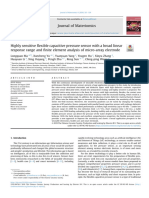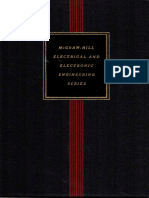Decibel Conversion
Uploaded by
Mushtaq AhmadDecibel Conversion
Uploaded by
Mushtaq AhmadDecibel
From Wikipedia, the free encyclopedia
This article is about the ratio of measures. For sound or acoustic level, see Sound pressure. For other
uses, see Decibel (disambiguation).
dB power ratio amplitude ratio
100 10 000 000 00
0
100 000
90 1 000 000 000 31 620
80 100 000 000 10 000
70 10 000 000 3 162
60 1 000 000 1 000
50 100 000 316.2
40 10 000 100
30 1 000 31.62
20 100 10
10 10 3.162
3 1.995 1.413
1 1.259 1.122
0 1 1
-10 0.1 0.316 2
-20 0.01 0.1
-30 0.001 0.031 62
-40 0.000 1 0.01
-50 0.000 01 0.003 162
-60 0.000 001 0.001
-70 0.000 000 1 0.000 316 2
-80 0.000 000 01 0.000 1
-90 0.000 000 001 0.000 031 62
-100 0.000 000 000
1
0.000 01
An example scale showing power ratios x and
amplitde ratios !x and d" e#i$alents 10 log10 x. %t
is easier to grasp and compare 2- or 3-digit nm&ers
than to compare p to 10 digits.
The decibel (dB) is a logarithmic unit that indicates the ratio of a physical quantity
(usually power or intensity) relative to a specified or implied reference level ! ratio in decibels is ten
times the logarithm to base "# of the ratio of two power quantities
$"%
! decibel is one tenth of a bel, a
seldom&used unit named in honor of !le'ander (raham )ell
The decibel is used for a wide variety of measurements in science and engineering, most prominently
in acoustics, electronics, and control theory *n electronics, the gains of amplifiers, attenuation of
signals, and signal&to&noise ratios are often e'pressed in decibels The decibel confers a number of
advantages, such as the ability to conveniently represent very large or small numbers, and the ability
to carry out multiplication of ratios by simple addition and subtraction
! change in power ratio by a factor of "# is a "# d) change ! change in power ratio by a factor of two
is appro'imately a + d) change
The decibel symbol is often qualified with a suffi', that indicates which reference quantity or frequency
weighting function has been used For e'ample, dBm indicates a reference level of one milliwatt,
while dBu is referenced to appro'imately #,,- volts ./0
$1%
The definitions of the decibel and bel use base "# logarithms The neper, an alternative logarithmic
ratio unit sometimes used, uses the natural logarithm (base e)
$+%
Contents
'hide(
1 )istor*
2 +e,inition
o 2.1 -ower #antities
o 2.2 .ield #antities
o 2.3 /xamples
3 0erits
4 1ses
o 4.1 Acostics
o 4.2 /lectronics
o 4.3 2ptics
o 4.4 3ideo and digital imaging
5 4,,ixes and re,erence le$els
o 5.1 3oltage
o 5.2 Acostics
o 5.3 Adio electronics
o 5.4 5adar
o 5.5 5adio power6 energ*6 and ,ield strength
o 5.6 Antenna measrements
o 5.7 2ther measrements
6 4ee also
7 5e,erences
8 /xternal lin7s
[edit]History
The decibel originates from methods used to quantify reductions in audio levels in telephone circuits
These losses were originally measured in units of Miles of Standard Cable(/02), where " /02
corresponded to the loss of power over a " mile (appro'imately "3 km) length of
standard telephone cable at a frequency of -### radians per second (,4-5 67), and roughly matched
the smallest attenuation detectable to the average listener 0tandard telephone cable was defined as
8a cable having uniforml distributed resistance of !! ohms per loop mile and uniforml
distributed shunt capacitance of ."#$ microfarad per mile8 (appro'imately "4 gauge)
$9%
The transmission unit (T:) was devised by engineers of the )ell Telephone ;aboratories in the "41#s
to replace the /02 " T: was defined as ten times the base&"# logarithm of the ratio of measured
power to a reference power level
$-%
The definitions were conveniently chosen such that " T:
appro'imately equaled " /02 (specifically, "#-3 T: < " /02)
$3%
*n "415, the )ell system renamed
the T: the decibel
$,%
!long with the decibel, the )ell 0ystem defined the bel, the base&"# logarithm of
the power ratio, in honor of their founder and telecommunications pioneer !le'ander (raham )ell
$5%
The bel is seldom used, as the decibel was the proposed working unit
$4%
The naming and early definition of the decibel is described in the =)0 0tandard>s ?earbook of "4+"@
$"#%
0ince the earliest days of the telephone, the need for a unit in which to measure the transmission efficiency
of telephone facilities has been recogni7ed The introduction of cable in "543 afforded a stable basis for a
convenient unit and the 8mile of standard8 cable came into general use shortly thereafter This unit was
employed up to "41+ when a new unit was adopted as being more suitable for modern telephone work The
new transmission unit is widely used among the foreign telephone organi7ations and recently it was termed
the 8decibel8 at the suggestion of the *nternational !dvisory 2ommittee on ;ong Distance Telephony
The decibel may be defined by the statement that two amounts of power differ by " decibel when they are in
the ratio of "#
#"
and any two amounts of power differ by = decibels when they are in the ratio of "#
=(#")
The
number of transmission units e'pressing the ratio of any two powers is therefore ten times the common
logarithm of that ratio This method of designating the gain or loss of power in telephone circuits permits
direct addition or subtraction of the units e'pressing the efficiency of different parts of the circuit
*n !pril 1##+, the *nternational 2ommittee for Weights and /easures (2*A/) considered a
recommendation for the decibel>s inclusion in the *nternational 0ystem of :nits (0*), but decided not to
adopt the decibel as an 0* unit
$""%
6owever, the decibel is recogni7ed by other international bodies
such as the *nternational Blectrotechnical 2ommission (*B2)
$"1%
The *B2 permits the use of the decibel
with field quantities as well as power and this recommendation is followed by many national standards
bodies, such as =*0T, which Custifies the use of the decibel for voltage ratios
$"+%
[edit]Definition
! decibel (d)) is one tenth of a bel ()), ie, ") < "#d) The bel represents a ratio between two power
quantities of "#@", and a ratio between two field quantities of
$"9%
! field %uantit is a quantity
such as voltage, current, sound pressure, electric field strength, velocity and charge density, the
square of which in linear systems is proportional to power ! po&er %uantit is a power or a quantity
directly proportional to power, eg, energy density, acoustic intensity and luminous intensity
The calculation of the ratio in decibels varies depending on whether the quantity being measured is
a po&er %uantit or a field %uantit
Two signals that differ by one decibel have a power ratio of "1-541 (or ) and an amplitude ratio
of ""11#1 (or )
$"-%
[edit]Power quantities
When referring to measurements of po&er or intensit, a ratio can be e'pressed in decibels by
evaluating ten times the base&"# logarithm of the ratio of the measured quantity to the reference level
Thus, the ratio of a power value '" to another power value '# is represented by (d), that ratio
e'pressed in decibels,
$"3%
which is calculated using the formula@
The base&"# logarithm of the ratio of the two power levels is the number of bels The number of
decibels is ten times the number of bels (equivalently, a decibel is one&tenth of a
bel)'" and '# must measure the same type of quantity, and have the same units before
calculating the ratio *f '" < '# in the above equation, then (d) < # *f '" is greater
than '#then (d) is positiveD if '" is less than '# then (d) is negative
.earranging the above equation gives the following formula for '" in terms of '# and (d)@
0ince a bel is equal to ten decibels, the corresponding formulae for measurement in bels (())
are
[edit]Field quantities
When referring to measurements of field amplitude, it is usual to consider the ratio of
the squares of )" (measured amplitude) and )# (reference amplitude) This is
because in most applications power is proportional to the square of amplitude, and it
is desirable for the two decibel formulations to give the same result in such typical
cases Thus the following definition is used@
The equivalence of and is one of the
standard properties of logarithms
The formula may be rearranged to give
0imilarly, in electrical circuits, dissipated power is typically proportional to
the square of voltage or current when the impedance is held constant
Taking voltage as an e'ample, this leads to the equation@
where *" is the voltage being measured, *# is a specified reference
voltage, and +d) is the power gain e'pressed in decibels ! similar
formula holds for current
[edit]Examples
!ll of these e'amples yield dimensionless answers in d) because they
are relative ratios e'pressed in decibels =ote that the unit 8d)W8 is
often used to denote a ratio where the reference is " W, and similarly
8d)m8 for a " mW reference point
To calculate the ratio of " kW (one kilowatt, or "### watts) to " W
in decibels, use the formula
To calculate the ratio of
to in decibels, use the formula
=otice that ,
illustrating the consequence from the definitions above
that has the same value, , regardless of
whether it is obtained from powers or from amplitudes,
provided that in the specific system being considered power
ratios are equal to amplitude ratios squared
To calculate the ratio of " mW (one milliwatt) to "# W in
decibels, use the formula
To find the power ratio corresponding to a + d)
change in level, use the formula
! change in power ratio by a factor of "# is a "# d)
change ! change in power ratio by a factor of two is
appro'imately a + d) change /ore precisely, the
factor is "#
+E"#
, or "44-+, about #19F different from
e'actly 1 0imilarly, an increase of + d) implies an
increase in voltage by a factor of appro'imately ,
or about "9", an increase of 3 d) corresponds to
appro'imately four times the power and twice the
voltage, and so on *n e'act terms the power ratio is
"#
3E"#
, or about +45"", a relative error of about
#-F
[edit]Merits
The use of the decibel has a number of merits@
The decibel>s logarithmic nature means that a
very large range of ratios can be represented
by a convenient number, in a similar manner
to scientific notation This allows one to clearly
visuali7e huge changes of some quantity
(0ee )ode Alot and half logarithm graph)
The overall gain of a multi&component system
(such as consecutive amplifiers) can be
calculated by summing the decibel gains of the
individual components, rather than multiply the
amplification factors (ie log(! G ) G 2) < log(!)
H log()) H log(2))
The human perception of the intensity of, for
e'ample, sound or light, is more nearly
proportional to the logarithm of intensity than to
the intensity itself, per the WeberIFechner law,
so the d) scale can be useful to describe
perceptual levels or level differences
[edit]Uses
[edit]coustics
Main article, Sound pressure
The decibel is commonly used in acoustics to
quantify sound levels relative to a # d) reference
which has been defined as a sound pressure level
of ###1 microbar, or 1#micropascals
$",%
The
reference level is set at the typical threshold of
perception of an average human and there
are common comparisons used to illustrate different
levels of sound pressure 0ound pressure is a field
quantity, so the formula used to calculate sound
pressure level is the field version@
where pref is equal to the standard reference sound pressure level of 1# micropascals
The human ear has a large dynamic
range in audio perception The ratio of the
sound intensity that causes permanent
damage during short e'posure to the
quietest sound that the ear can hear is
greater than or equal to " trillion
$"5%
0uch
large measurement ranges are
conveniently e'pressed in logarithmic
units@ the base&"# logarithm of one trillion
("#
"1
) is "1, which is e'pressed as an
audio level of "1# d) 0ince the human ear
is not equally sensitive to all sound
frequencies, noise levels at ma'imum
human sensitivityJsomewhere between 1
and 9 k67Jare factored more heavily into
some measurements using frequency
weighting (0ee also 0tevens> power law)
Further information, -.amples of sound
pressure and sound pressure levels
[edit]Electronics
*n electronics, the decibel is often used to
e'press power or amplitude ratios (gains),
in preference to arithmetic ratios
or percentages Kne advantage is that the
total decibel gain of a series of
components (such
as amplifiers and attenuators) can be
calculated simply by summing the decibel
gains of the individual components
0imilarly, in telecommunications, decibels
denote signal gain or loss from a
transmitter to a receiver through some
medium (free
space, waveguide, coa', fiber optics, etc)
using a link budget
The decibel unit can also be combined with
a suffi' to create an absolute unit of
electric power For e'ample, it can be
combined with 8m8 for 8milliwatt8 to
produce the 8d)m8 Lero d)m equals one
milliwatt, and " d)m is one decibel greater
(about "1-4 mW)
*n professional audio, a popular unit is the
d)u (see below for all the units) The 8u8
stands for 8unloaded8, and was probably
chosen to be similar to lowercase 8v8, as
d)v was the older name for the same
thing *t was changed to avoid confusion
with d)M This unit (d)u) is
an ./0 measurement of voltage which
uses as its reference appro'imately #,,-
M./0 2hosen for historical reasons, the
reference value is the voltage level which
delivers " mW of power in a 3## ohm
resistor, which used to be the standard
reference impedance in telephone audio
circuits
[edit]!ptics
*n an optical link, if a known amount
of optical power, in d)m (referenced to
" mW), is launched into a fiber, and the
losses, in d) (decibels), of each electronic
component (eg, connectors, splices, and
lengths of fiber) are known, the overall link
loss may be quickly calculated by addition
and subtraction of decibel quantities
$"4%
*n spectrometry and optics, the blocking
unit used to measure optical density is
equivalent to N" )
[edit]"ideo and di#ital ima#in#
*n connection with video and digital image
sensors, decibels generally represent
ratios of video voltages or digiti7ed light
levels, using 1# log of the ratio, even when
the represented optical power is directly
proportional to the voltage or level, not to
its square, as in a 22D imager where
response voltage is linear in intensity
$1#%
Thus, a camera signal&to&noise
ratio or dynamic range of 9# d) represents
a power ratio of "##@" between signal
power and noise power, not "#,###@"
$1"%
0ometimes the 1# log ratio definition is
applied to electron counts or photon counts
directly, which are proportional to intensity
without the need to consider whether the
voltage response is linear
$11%
6owever, as mentioned above, the "# log
intensity convention prevails more
generally in physical optics, including fiber
optics, so the terminology can become
murky between the conventions of digital
photographic technology and physics /ost
commonly, quantities called 8dynamic
range8 or 8signal&to&noise8 (of the camera)
would be specified in 1# log d)s, but in
related conte'ts (eg attenuation, gain,
intensifier 0=., or reCection ratio) the term
should be interpreted cautiously, as
confusion of the two units can result in very
large misunderstandings of the value
Ahotographers also often use an
alternative base&1 log unit, the f&stop, and
in software conte'ts these image level
ratios, particularly dynamic range, are often
loosely referred to by the number of bits
needed to represent the quantity, such that
3# d) (digital photographic) is roughly
equal to "# f&stops or "# bits, since "#
+
is
nearly equal to 1
"#
[edit]$uffixes and reference
le%els
0uffi'es are commonly attached to the
basic d) unit in order to indicate the
reference level against which the decibel
measurement is taken For e'ample, d)m
indicates power measurement relative to "
milliwatt
*n cases such as this, where the numerical
value of the reference is e'plicitly and
e'actly stated, the decibel measurement is
called an 8absolute8 measurement, in the
sense that the e'act value of the measured
quantity can be recovered using the
formula given earlier *f the numerical value
of the reference is not e'plicitly stated, as
in the d) gain of an amplifier, then the
decibel measurement is purely relative
The 0* does not permit attaching qualifiers
to units, whether as suffi' or prefi', other
than standard 0* prefi'es Therefore, even
though the decibel is accepted for use
alongside 0* units, the practice of attaching
a suffi' to the basic d) unit, forming
compound units such as d)m, d)u, d)!,
etc, is not
$1+%
6owever, outside of
documents adhering to 0* units, the
practice is very common as illustrated by
the following e'amples
[edit]"olta#e
0ince the decibel is defined with respect to
power, not amplitude, conversions of
voltage ratios to decibels must square the
amplitude, or use the factor of 1# instead
of "#, as discussed above
! schematic showing the relationship
between d)u (thevoltage source) and d)m (the
power dissipated as heat by the 3## O resistor)
dB"
d)(" M./0) I voltage relative to " volt, regardless of impedance
$1%
dBu or dB%
./0 voltage relative to
$1%
Kriginally d)v,
it was changed to d)u to avoid confusion with d)M
$19%
The 8v8 comes from 8volt8, while 8u8
comes from 8unloaded8 d)u can be used regardless of impedance, but is derived from a
3## O load dissipating # d)m (" mW) The reference voltage comes from the
computation
*n professional audio, equipment may be calibrated to indicate a 8#8 on the M: meters some
finite time after a signal has been applied at an amplitude of H9 d)u 2onsumer equipment will
more often use a much lower 8nominal8 signal level of &"# d)M
$1-%
Therefore, many devices
offer dual voltage operation (with different gain or 8trim8 settings) for interoperability reasons !
switch or adCustment that covers at least the range between H9 d)u and &"# d)M is common
in professional equipment
dBm"
d)(" mM./0) I voltage relative to " millivolt across ,- O
$13%
Widely used in cable
television networks, where the nominal strength of a single TM signal at the receiver terminals
is about # d)mM 2able TM uses ,- O coa'ial cable, so # d)mM corresponds to N,5,- d)W
(N95,- d)m) or P"+ nW
dB&" or dBu"
d)(" QM./0) I voltage relative to " microvolt Widely used in television and aerial amplifier
specifications 3# d)QM < # d)mM
[edit]coustic
s
Arobably the most
common usage of
8decibels8 in
reference to sound
loudness is d)
0A;, sound
pressure
level referenced to
the nominal
threshold of human
hearing@
$1,%
The
measures of
pressure, a field
quantity, use the
factor of 1#, and the
measures of power
(eg d) 0*; and d)
0W;) use the factor
of "#
dB'$P()
d) (sound pressure level) I for sound in air and other gases, relative to 1# micropascals
(QAa) < 1G"#
N-
Aa, the quietest sound a human can hear This is roughly the sound of a
mosquito flying + meters away This is often abbreviated to Cust 8d)8, which gives some the
erroneous notion that 8d)8 is an absolute unit by itself For sound in water and other liquids, a
reference pressure of " QAa is used
$15%
Kne Aascal is
equal to
49 d)(0A;)
This level is
used to specify
microphone
sensitivity For
e'ample, a
typical
microphone
may put out
1# mM at one
pascal For
other sound
pressure levels,
the output
voltage can be
computed from
this basis,
e'cept that
noise and
distortion will
affect the
e'treme levels
dB'P)
d) I relative to " Aa, often used in telecommunications
$citation needed%
dB $*(
d) sound intensity level I relative to "#
N"1
WEm
1
, which is roughly the threshold of human
hearing in air
dB
$+(
d) sound power level I relative to "#
N"1
W
d
B
'
),
d
B
'
B
),
a
n
d
d
B
'
,
)
These symbols are often used to denote the use of different weighting filters, used to
appro'imate the human ear>s response to sound, although the measurement is still in d)
(0A;) These measurements usually refer to noise and noisome effects on humans and
animals, and are in widespread use in the industry with regard to noise control issues,
regulations and environmental standards Kther variations that may be seen are d)! or d)!
!ccording to !=0* standards, the preferred usage is to write ;! < ' d) =evertheless, the units
d)! and d)(!) are still commonly used as a shorthand for !&weighted measurements
2ompare d)c, used in telecommunications
d
B
H
(
or
d)
he
ari
ng
le
ve
l is
us
ed
in
au
di
og
ra
m
s
as
a
m
ea
su
re
of
he
ari
ng
lo
ss
Th
e
ref
er
en
ce
le
ve
l
va
rie
s
wit
h
fre
qu
en
cy
ac
co
rdi
ng
to
a
mi
ni
m
u
m
au
di
bili
ty
cu
rv
e
as
de
fin
ed
in
!
=
0*
an
d
ot
he
r
st
an
da
rd
s,
su
ch
th
at
th
e
re
su
lti
ng
au
di
og
ra
m
sh
o
ws
de
vi
ati
on
fro
m
w
ha
t
is
re
ga
rd
ed
as
>n
or
m
al>
he
ari
ng
$cita
tion
nee
ded%
d
B
-
is
so
m
eti
m
es
us
ed
to
de
no
te
w
ei
gh
te
d
no
is
e
le
ve
l,
co
m
m
on
ly
us
in
g
th
e *
T
:&
.
93
5
no
is
e
w
ei
gh
tin
g
$ci
tatio
n
nee
ded%
[e
di
t]
u
di
o
el
e
ct
r
o
ni
c
s
d
B
m
d)(mW) I power relative to " milliwatt *n audio and telephony, d)m is typically referenced
relative to a 3## ohm impedance,
$14%
while in radio frequency work d)m is typically referenced
relative to a -# ohm impedance
$+#%
dBF$
d)(full scale) I the amplitude of a signal compared with the ma'imum which a device can
handle before clipping occurs Full&scale may be defined as the power level of a full&
scale sinusoid or alternatively a full&scale square wave # d)F0(square wave) < &+ d)F0(sine
wave)
dB.P
d)(true peak) & peak amplitude of a signal compared with the ma'imum which a device can
handle before clipping occurs
$+"%
*n digital systems, # d)TA would equal the highest level
(number) the processor is capable of representing /easured values are always negative or
7ero, since they are less than or equal to full&scale
[edit]/adar
dB0
d)(L) I energy of reflectivity (weather radar), related to the amount of transmitted power
returned to the radar receiverD the reference level for L is " mm
3
m
N+
Malues above "-I1# d)L
usually indicate falling precipitation
$+1%
dBsm
d)sm I decibel measure of the radar cross section (.20) of a target relative one square
meter The power reflected by the target is proportional to its .20 80tealth8 aircraft and
insects have negative .20 measured in d)sm, large flat plates or non&stealthy aircraft have
positive values
$++%
[edit]/adio power1
ener#y1 and field
stren#t2
dBc
d)c I relative to carrierJin telecommunications, this indicates the relative levels of noise or
sideband power, compared with the carrier power 2ompare d)2, used in acoustics
dB3
d)(R) I energy relative to " Coule " Coule < " watt second < " watt per hert7, so power spectral
density can be e'pressed in d)R
dBm
d)(mW) I power relative to " milliwatt Traditionally associated with the telephone and
broadcasting industry to e'press audio&power levels referenced to one milliwatt of power,
normally with a 3## ohm load which is a voltage level of #,,- volts or ,,- millivolts 0till
commonly used to e'press audio levels with professional audio equipment
*n the radio field, d)m is usually
referenced to a -# ohm load, with the
resultant voltage being #119 volts
dB&"4m or dBu"4m
d)(QMEm) I electric field strength relative to " microvolt per meter Kften used to specify the
signal strength from a television broadcast at a receiving site (the signal measuredat the
antenna output will be in d)QM)
dBf
d)(fW) I power relative to " femtowatt
dB+
d)(W) I power relative to " watt
dB5
d)(kW) I power relative to " kilowatt
[edit]ntenna measurements
dBi
d)(isotropic) I the forward gain of an antenna compared with the hypothetical isotropic
antenna, which uniformly distributes energy in all directions ;inear polari7ation of the B/ field
is assumed unless noted otherwise
dBd
d)(dipole) I the forward gain of an antenna compared with a half&wave dipole antenna # d)d
< 1"- d)i
dBi,
d)(isotropic circular) I the forward gain of an antenna compared to a circularly
polari7ed isotropic antenna There is no fi'ed conversion rule between d)i2 and d)i, as it
depends on the receiving antenna and the field polari7ation
dBq
d)(quarterwave) I the forward gain of an antenna compared to a quarter wavelength whip
.arely used, e'cept in some marketing material # d)q < N#5- d)i
[edit]!t2er measurements
dB6H7
d)(hert7) I bandwidth relative to " 67 Bg, 1# d)&67 corresponds to a bandwidth of "## 67
2ommonly used in link budget calculations !lso used in carrier&to&noise&density ratio (not to
be confused with carrier&to&noise ratio, in d))
dBo% or dB!
d)(overload) I the amplitude of a signal (usually audio) compared with the ma'imum which a
device can handle before clipping occurs 0imilar to d)F0, but also applicable to analog
systems
dBr
d)(relative) I simply a relative difference from something else, which is made apparent in
conte't The difference of a filter>s response to nominal levels, for instance
dBrn
d) above reference noise 0ee also d)rn2
You might also like
- UHF CB Australia - 80 Channel UHF CB Radio Information & AllocationsNo ratings yetUHF CB Australia - 80 Channel UHF CB Radio Information & Allocations2 pages
- Unit of Measure - DB, DBD, DBi, DBM, DBW and DBMVNo ratings yetUnit of Measure - DB, DBD, DBi, DBM, DBW and DBMV8 pages
- Different Types of Signal Cable Connector and TheirNo ratings yetDifferent Types of Signal Cable Connector and Their22 pages
- Lecture Slides Chapter 2 Fundamentals of ElectronicsNo ratings yetLecture Slides Chapter 2 Fundamentals of Electronics70 pages
- 6 - Non - Linear - Schroedinger - Equation PDFNo ratings yet6 - Non - Linear - Schroedinger - Equation PDF25 pages
- Network Infrastructure Windows Server: IP Address and SubnettingNo ratings yetNetwork Infrastructure Windows Server: IP Address and Subnetting42 pages
- Network Cabling and Devices: Implementation Techniques of Various TypesNo ratings yetNetwork Cabling and Devices: Implementation Techniques of Various Types67 pages
- Computer Systems: Hardware (Book No. 1 Chapter 2)No ratings yetComputer Systems: Hardware (Book No. 1 Chapter 2)82 pages
- UCCN1004 - Lect2a - Intro To Network Devices - AddressingNo ratings yetUCCN1004 - Lect2a - Intro To Network Devices - Addressing28 pages
- Field Programmable Gate Array Implementation of 14 Bit Sigma-Delta Analog To Digital ConverterNo ratings yetField Programmable Gate Array Implementation of 14 Bit Sigma-Delta Analog To Digital Converter4 pages
- Digital/Analog Migration IDAS™ Conventional IP Network IDAS™ TrunkingNo ratings yetDigital/Analog Migration IDAS™ Conventional IP Network IDAS™ Trunking8 pages
- Network Connections: Networking HardwareNo ratings yetNetwork Connections: Networking Hardware60 pages
- Impedance Matching and The Smith Chart: The Fundamentals100% (1)Impedance Matching and The Smith Chart: The Fundamentals18 pages
- Computer Networks and Internet Protocol (NPTEL) - Week 4No ratings yetComputer Networks and Internet Protocol (NPTEL) - Week 467 pages
- Noise Basics: To Order Call 201-261-8797No ratings yetNoise Basics: To Order Call 201-261-87973 pages
- Filter and Combiners Topics-PhilippinesNo ratings yetFilter and Combiners Topics-Philippines30 pages
- User Manual - 900 1800 2100 Tri Band Repeater - RP33EDWNo ratings yetUser Manual - 900 1800 2100 Tri Band Repeater - RP33EDW12 pages
- Analog Communication - Transmitters & Receiver by Arijit Manna (Midnapore City College, Post Graduate 1 Sem)No ratings yetAnalog Communication - Transmitters & Receiver by Arijit Manna (Midnapore City College, Post Graduate 1 Sem)7 pages
- Computer Assembly and Repair Lab Manual AbuNo ratings yetComputer Assembly and Repair Lab Manual Abu63 pages
- Radio Spectrum Management: Policies, Regulations and TechniquesFrom EverandRadio Spectrum Management: Policies, Regulations and TechniquesNo ratings yet
- Cross Band Repeater Conncetions of DB 9pinNo ratings yetCross Band Repeater Conncetions of DB 9pin1 page
- Crime and Criminal Tracking Network System: Case StudyNo ratings yetCrime and Criminal Tracking Network System: Case Study2 pages
- Multi-Family Division: The Knoxville I TownhouseNo ratings yetMulti-Family Division: The Knoxville I Townhouse16 pages
- Ua08 9300 W-Cdma r99 Algorithms-Tmo18255 - v2No ratings yetUa08 9300 W-Cdma r99 Algorithms-Tmo18255 - v2583 pages
- Finale 2008a - (Harmonic Journey - Battery - Mus)No ratings yetFinale 2008a - (Harmonic Journey - Battery - Mus)4 pages
- Antennas Terman McGraw Hill Engineering 1953No ratings yetAntennas Terman McGraw Hill Engineering 1953566 pages
- Motional Feedback On A Loudspeaker WooferNo ratings yetMotional Feedback On A Loudspeaker Woofer122 pages
- Principles of Electronic Communication Systems 3rd Edition by Frenzel Louis e Textbook PDF DownloadNo ratings yetPrinciples of Electronic Communication Systems 3rd Edition by Frenzel Louis e Textbook PDF Download1 page
- Revenue Regulations No. 11-2004 SUBJECT: Rules and Regulations On The Accreditation, Registration and Use of CashNo ratings yetRevenue Regulations No. 11-2004 SUBJECT: Rules and Regulations On The Accreditation, Registration and Use of Cash0 pages
- Implementasi Kebijakan Penanggulangan Kemiskinan Melalui Program Keluarga Harapan Di Kecamatan Tamalate Kota MakassarNo ratings yetImplementasi Kebijakan Penanggulangan Kemiskinan Melalui Program Keluarga Harapan Di Kecamatan Tamalate Kota Makassar9 pages
- Microsoft Corporation Vs Samir GR No. 205800, September 10, 2014 FactsNo ratings yetMicrosoft Corporation Vs Samir GR No. 205800, September 10, 2014 Facts1 page
- UHF CB Australia - 80 Channel UHF CB Radio Information & AllocationsUHF CB Australia - 80 Channel UHF CB Radio Information & Allocations
- Different Types of Signal Cable Connector and TheirDifferent Types of Signal Cable Connector and Their
- Lecture Slides Chapter 2 Fundamentals of ElectronicsLecture Slides Chapter 2 Fundamentals of Electronics
- Network Infrastructure Windows Server: IP Address and SubnettingNetwork Infrastructure Windows Server: IP Address and Subnetting
- Network Cabling and Devices: Implementation Techniques of Various TypesNetwork Cabling and Devices: Implementation Techniques of Various Types
- UCCN1004 - Lect2a - Intro To Network Devices - AddressingUCCN1004 - Lect2a - Intro To Network Devices - Addressing
- Field Programmable Gate Array Implementation of 14 Bit Sigma-Delta Analog To Digital ConverterField Programmable Gate Array Implementation of 14 Bit Sigma-Delta Analog To Digital Converter
- Digital/Analog Migration IDAS™ Conventional IP Network IDAS™ TrunkingDigital/Analog Migration IDAS™ Conventional IP Network IDAS™ Trunking
- Impedance Matching and The Smith Chart: The FundamentalsImpedance Matching and The Smith Chart: The Fundamentals
- Computer Networks and Internet Protocol (NPTEL) - Week 4Computer Networks and Internet Protocol (NPTEL) - Week 4
- User Manual - 900 1800 2100 Tri Band Repeater - RP33EDWUser Manual - 900 1800 2100 Tri Band Repeater - RP33EDW
- Analog Communication - Transmitters & Receiver by Arijit Manna (Midnapore City College, Post Graduate 1 Sem)Analog Communication - Transmitters & Receiver by Arijit Manna (Midnapore City College, Post Graduate 1 Sem)
- Radio Spectrum Management: Policies, Regulations and TechniquesFrom EverandRadio Spectrum Management: Policies, Regulations and Techniques
- Crime and Criminal Tracking Network System: Case StudyCrime and Criminal Tracking Network System: Case Study
- Principles of Electronic Communication Systems 3rd Edition by Frenzel Louis e Textbook PDF DownloadPrinciples of Electronic Communication Systems 3rd Edition by Frenzel Louis e Textbook PDF Download
- Revenue Regulations No. 11-2004 SUBJECT: Rules and Regulations On The Accreditation, Registration and Use of CashRevenue Regulations No. 11-2004 SUBJECT: Rules and Regulations On The Accreditation, Registration and Use of Cash
- Implementasi Kebijakan Penanggulangan Kemiskinan Melalui Program Keluarga Harapan Di Kecamatan Tamalate Kota MakassarImplementasi Kebijakan Penanggulangan Kemiskinan Melalui Program Keluarga Harapan Di Kecamatan Tamalate Kota Makassar
- Microsoft Corporation Vs Samir GR No. 205800, September 10, 2014 FactsMicrosoft Corporation Vs Samir GR No. 205800, September 10, 2014 Facts










































































































